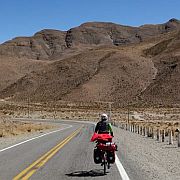 |
Stage 2022/07 [SA007] | ||
|
Pozo Colorado - Salina Grandes - Susques |
|||
| 75 km / 47 mi | |||
| 682 Hm (garmin edge 1000) max. Altitude: 3880 m | |||
Cycling Argentina's Andes following R52 from Salinas Grandes to Susques. |
|
|
Cycling the first section from Pozo Colorado to the northern tip of Salinas Grandes is not easy due to the sandy soil. We take the shortest way to the saline using tracks we find on the ground, avoiding the bumpy road east of the Salina. |
|
|
After a few minutes we are right on at the salt and enjoy cycling on the huge salt crust again. Yesterday we saw that the salt crust is broken in some places and the salt water can come to light, so it might be a good idea to stick to dirty tracks on the salt. The main road R52 can be seen from a distance and we head for the point on the horizon where the road leaves Salinas Grandes to the west. After 10 kilometers we leave the saltworks and enter the asphalted road. Driving from the saltworks to the higher road is completely problem-free. |
|
|
The R52 is in very good condition, there are even signs indicating that there might be some cyclists. The terrain up herein Argentina's Puna is completely flat and you are totally exposed to the wind that blows over the main ridge of the Andes. In August (it's winter here) the wind comes from the west, exactly from the direction we are currently traveling. |
|
|
|
|
 After our second breakfast we continue west on the R52. The terrain is still flat here, but the headwind is now picking up. Since we researched the weather situation in this area in advnce, we know that the wind isn't going to get any better now. |
|
 At the end of the endless long straight section, the first gentle hills appear and we hope that the topology of the terrain will slow down the wind a bit. Which of course isn't the case, but on a bicycle your mind desperatly wants to believe something like that. |
|
 The road isin a remarkable good condition: considering the extreme temperatures, sunlight and heavy traffic, the road is in a good shape, there are hardly any potholes. |
|
|
After 50 kilometers it gets a bit mountainous again. The western mountain range of the Andes, which separates us from the Atacama Desert, lies in front of us. We follow the road uphill, but with a gradient of 5 - 6% the the elevation gain is easy to handle. The main problem here is clearly the wind. |
|
 But the climb doesn't protect us from the headwind, which becomes more unpleasant with every minute. The temperatures are quite enjoyable at 18°C, but the R52 east of Susques does not have any topology that protects us from the wind. |
|
|
The mountains up here are still very impressive. The path from the Cuesta de Lipán to here is indescribably beautiful. However, I'm starting to lose the energy to enjoy the beauty of the mountains because all I'm thinking about is the wind. Luckily we are not under time pressure: there are plenty of opportunities to camp on the left and right of the road, so there is no reason to force ourself to Susques today. But now, so close to the top of the pass, we won't give up. |
|
 The highest point on the route to Susques is at around 3880m 12,730ft. This is also the place with the strongest wind. Actually, there are two pass heights and to make matters worse, this pass doesn't even have a name or at least a sign that gives you the satisfaction of having accomplished something. Or anything that simply provides slipstream. |
|
|
We fight our way through the never-ending wind and eventually reach the descent to Susques, the capital of the department of the same name in the Jujuy province, located in the utmost northwest of Argentina. |
|
|
Susques is the highest town in Argentina accessible by asphalt road. The supply options are limited, the place gives the impression of not being able to cater the needs travelers. Hence Marion and I have a hard time to find a place for dinner. Like anywhere elas in the Andes, as soon as the sun disappears behind the mountain peaks, it instantly becomes freezing cold and it is better to stay indoors. |
|












